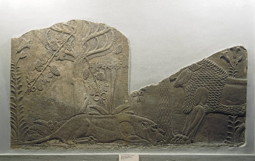Tašmetu (goddess)
Divine consort of the scribe god Nabu, associated with wisdom and sexual attractiveness.
Functions

Wall relief panel depicting a garden scene; from Assyrian king Assurbanipal's North Palace, Nineveh; 645–640 BCE. This natural scene shows with lions resting beside a palm and, perhaps, a cypress tree. Bunches of grapes hang from vines and daisy-like flowers grow beside them. Although this imagery is not directly related to the goddess Tašmetu, it provides a glimpse into the luxuriant gardens described in literary texts featuring the goddess. (BM 118914,a). © The British Museum. View large image on the British Museum's website.
Tašmetu's main role is that of wife to Nabu, the divine scribe of destinies. Nabu functions as a god of wisdom, because knowledge and learning were often transmitted in written form. Tašmetu also becomes linked with wisdom herself, by association with her husband. She also has a link with sexual attractiveness, which may stem from a shared aspect with the goddess Nanaya/Ištar, who is Nabu's consort in a parallel tradition.
Divine Genealogy and Syncretisms
Tašmetu is the daughter of the god Uraš, the deity of the northern Babylonian city of Dilbat. In first-millennium Assyria, Tašmetu was Nabu's consort but in Babylonia this role was taken by the goddess Nanaya (Inana/Ištar) (Pomponio 1998–200§: 21). Tašmetu shares aspects with Nanaya, particularly in her associations with sex and wisdom (Lapinkivi 2005).
Cult Place(s)
Tašmetu's cult centres are connected with places of worship for her consort Nabu. In Babylonia, Nabu was worshipped from the early second millennium and by the turn of the first millennium was one of the supreme gods of the region, alongside Marduk. In the Neo-Assyrian period, Tašmetu's cult was adopted in the city of Kalhu [~/images/Kalhu.jpg], along with worship of Nabu. In around 800 BCE Assyrian king Adad-nirari III built twin temples for for Nabu and Tašmetu in the Kalhu temple complex named Ezida (Millard, 1999: 607). These were later repaired by several of Adad-nirari III's successors (Oates 1957).
Time Periods Attested
Tašmetu is first attested as Nabu's consort. She appears relatively late and then only in fragmentary god lists from the Old Babylonian period (Pomponio 1998–2001: 21). In the first milllennium she is mentioned in texts from the Neo-Assyrian, Achaemenid and Seleucid periods (see online corpora below).
Nabu and Tašmetu's relationship is celebrated in a poetic composition from Assurbanipal's royal library at Nineveh, dating from the seventh century BCE (Foster 2005: 944-6; SAA 3, 14). This text is probably related to a ritual, in which the cult statues of Nabu and Tašmetu were brought together in a ceremonial 'marriage'. (Black and Green 1998: 157). (In Babylonian tradition, the 'marriage' was sometimes between Nabu and Nanaya.)
The narrative is set partly in the voices of the two deities, who rejoice in their relationship with each other. The love lyrics also contain a description of Nabu and Tašmetu's playful sexual encounters in a garden. Part of the ceremonial marriage involving Nabu and Tašmetu took place in a garden setting (SAA 13, 78), and references to fruit and gardens were enduring metaphors for sexual attraction in the ancient Near East (Veenker 1999/2000; Musche 1999).
Several surviving letters give accounts of actual such ceremonies that took place, presumably between the cult statues of Nabu and Tašmetu, in Kalhu during the 8th century BCE, providing vivid pictures of what the deities got up to during the ritual (Cole and Machinist 1998; (Matsushima 1987). One letter describes how Nabu and Tašmetu spent six days and seven nights in their wedding bedroom, during which they were served a royal banquet. Afterwards, Nabu was taken out to 'stretch his legs' and then hunted wild ox in the game park. Unfortunately, we aren't given details of Tašmetu's activities when she emerges from the bedroom (SAA 13, 70 [http://oracc.museum.upenn.edu/saao/saa13/P334242/]).
Tašmetu is mentioned in association with both sexual attractiveness and wisdom in first-millennium prayers from the city of Kalhu. She is deemed a wise goddess in a fragmentary prayer (CTN 4, 166). In another prayer (CTN 4, 168) she is described as the "queen and lady of the fates" (obv. ii 53). The same prayer also describes Tašmetu as a "goddess of sex appeal and sensuality" (rrev. i 25) and "mistress of the lovers in the inhabited world" (rev. ii 19). Tašmetu's associations with both sex and wisdom may stem from a shared aspect with Nabu's other consort Nanaya/Ištar (Lapinkivi 2005-11).
Tašmetu also appeared as a divine element in female personal names. Notably, Assyrian king Sennacherib (r.704-681 BCE) had a wife named Tašmetu-šarrat ("Tašmetu is queen"), who held an unusually prominent position by his side (Radner 2011.
Iconography
As yet, no sources of imagery depicting Tašmetu are known.
Name and Spellings
Pomponio (1998–2001: 21) suggests that Tašmetu's (Akkadian) name should be interpreted as "intelligence" due to her pairing with Nabu, the god of writing.
- Written forms:
- taš-me-tu4; dtaš-me-tu2; dtaš-me-tu4
- Normalised form:
- Tašmetu
Tašmetu in Online Corpora
Further reading
- Al-Mutawalli 1999, "A new foundation cylinder."
- Lapinkivi 2005-2011, "Lady at the window (1)."
- Matsushima 1987, "Le rituel hiérogamique de Nabû."
- Millard 1999, "Nabû."
- Nissinen 1998, "Love lyrics of Nabu and Tašmetu: an Assyrian Song of Songs?"
- Oates 1957, "Ezida: the temple of Nabu."
- Veenker 1999/2000, "Forbidden fruit."
Ruth Horry
Ruth Horry, 'Tašmetu (goddess)', Ancient Mesopotamian Gods and Goddesses, Oracc and the UK Higher Education Academy, 2019 [http://oracc.museum.upenn.edu/amgg/listofdeities/tametu/]